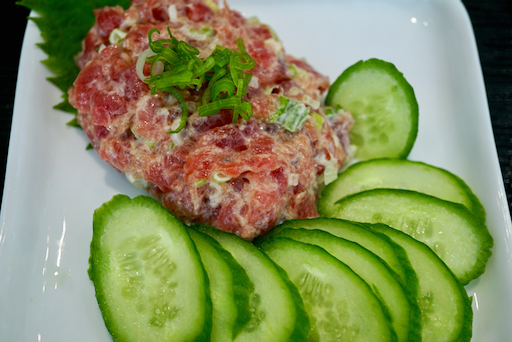Wednesday, March 23, 2016
Nagaimo and natto fry 長芋と納豆の落とし揚げ
Thursday, June 11, 2015
Grated nagaimo and onsen egg トロロ温泉卵入り
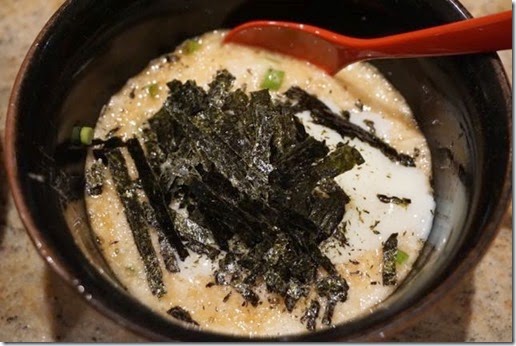
I grated the nagaimo, seasoned with soy sauce with wasabi and chopped scallion. Since I had onsen eggs 温泉卵 which I had made previously sitting in the refrigerator, I dropped that in the middle and garnished it with thin strips of nori seaweed.
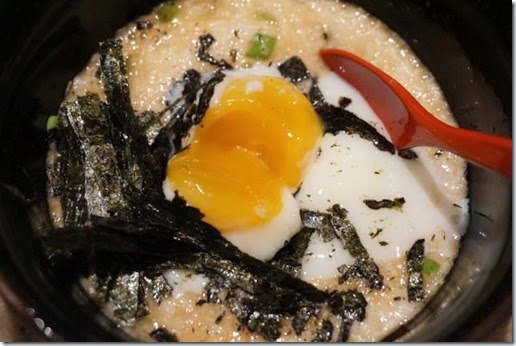
When you dig in you see the nice creamy egg yolk. The egg can be poured over rice and enjoyed as is the traditional way, we just ate as a accompaniment for sake. Since the potato has lots of starch, this is surprisingly filling and remarkably went well with sake.
Wednesday, June 23, 2010
"Mozuku" and "Nagaimo" in sweet vinegar モズクと長芋の甘酢
Friday, March 29, 2019
Bonito tataki yamakake variation 鰹のタタキ山かけ風
I dressed this using Ponzu sauce (from the bottle) and garnished with scallion.
Of course, sake is called for here. This is our new house-sake "Tengumai" daiginjo from Ishikawa prefecture 天狗舞純米大吟醸. We first had this in Kanazawa 金沢 (it was "yamahi junmai" 山廃純米). Recently we re-discovered this brand of sake and like it very much. Compared to our other house sake Yaegaki "Mu" daiginjo 八重垣無大吟醸 which is clean and fruity, tengumai has a bit more complexity and depth.
Ingredients (amounts are all arbitrary):
1. Nagaimo, peeled and cut into small cubes (#1).
2. Scallion, finely sliced and soaked in water and then drained (#2).
3. Bonito tataki, marinated in concentrated noodle sauce (from the bottle) overnight and cut into cubes (#3).
4. Mixed together and dressed in Ponzu sauce (from the bottle) ( #4).
This was a nice small dish. My wife liked this version since the nagaimo was nicely crunchy (instead of slimy). The bonito tataki lost any hint of fishiness and had a nice favor and texture. Perfect to have it with a bit of good cold sake.
Tuesday, April 13, 2010
Deep fried fish and mountain potato dumpling 薩摩揚げ(もどき)
Saturday, September 1, 2012
Ground Okra and Tuna sashimi cubes 鮪のオクラトロロ山かけ

Okra: This is one pack of okra (about 12 okra). I first rubbed the surface with kosher salt to remove the "fuzz" and washed away the salt. I blanched for 30 seconds to 1 minute in salted rapidly boiling water (or until the okra’s green color becomes bright). I then drained and dunked the okra into ice water to keep the green color (picture below). I removee the ends and roughly chopped them up. I used an emersion blender and the plastic container that came with the blender. I added an equal mixture of concentrated dipping sauce (menstuyu 麺つゆ) and water and I blended to get a nice consistency.

Tuna: I used the "akami" 赤身 portion of Bluefin tuna I got from Catalina. I just cut it into a bite size cubes and marinated in a mixture of soy sauce and sake (1:1) overnight in a refrigerator.
I assembled it exactly like "Yamakake". I poured the grated okra into the bottom of a small bowl, placed the marinated tuna cubes on top and garnished it with strips of nori and perilla.
The taste?? This is very interesting. This is slime on steroids. It is even more viscous than nagaimo (I could have put more liquid to make it looser) but it has the refreshing green taste of fresh okra. Certainly, this is very unique way of using okra. I may try a different variation in the future but we prefer nagaimo for yamakake dish. Amazingly, I was more resistant to the idea of this green slime than my wife was—she is definitely not a fan of okra but she seemed to like this.
Monday, July 29, 2019
Salmon and avocado cubes and Yamahai sake 鮭とアボカドの角切と山廃純米酒
Since the tuna was yellowfin tuna キハダマグロ, I marinated it after I cut it into small cubes in concentrated Japanese "men-tsuyu" noodle sauce 麺つゆ for several hours in the refrigerator to make it taste better. I seasoned grated nagaimo or "tororo" とろろ with wasabi dissolved in soy sauce, and placed the tuna on top after draining the excess marinade. I garnished it with strips of nori (I served more nori on the side). This is, of course, is a very common way to serve tuna and nagaimo and we both really like it. We added more nori as we enjoyed this dish.
Since I had limes, after I cut avocado into small cubes, I dressed the cubes with lime juice to prevent discoloration. Cubes of salmon were also marinated in Japanese concentrated noodle sauce in exactly same way as the tuna. I dressed them with finely chopped garlic, dark sesame oil and soy sauce and garnished it with chiffonade of perilla and finely chopped scallion. Since the salmon was much fattier than the tuna, it did not absorb the marinade as much but, over all, this dish really worked. Both the salmon and avocado had a similar oily texture.
As a third dish, I served 4 items on the small plate. Only one that is slightly new is the chicken tenderloin dressed in soy sauce, yuzu-kosho 柚子胡椒 and finely chopped edible chrysanthemum 春菊 (blanched, which I happened to have). The chicken tenderloin was removed from sous vide chicken breast. This was very good. The chrysanthemum gave a slightly bitter taste and went well with the moist tenderloin and yuzu-kosho flavor.
The remaining three items are "our usual suspects", Japanese dashi-maki omelet 青海苔入りだし巻きwith aonori, sugar snap blanched and soaked in salt-seasoned Japanese dashi broth スナップ豌豆の塩びたし, and simmered taro 里芋の煮付け.
This evening, we tried a new sake (although we had it before in Japan). It is Tengumai but not "daiginjo". This is Yamahai Junmai 山廃純米天狗舞. The label has a formal name of this old way of making sake 山卸廃止酛仕込(やまおろしはいしもとしこみ). Compared to our new house sake Tengumai daiginjo 天狗舞大吟醸, this is a quite different sake. I think we had this for the first time when we visited Kanazawa 4 years ago. This sake is savory/rich and dry and has earthy/mushroomy background flavor. Some sake expert suggested that this sake should not be served refrigerator cold but at room temperature and suggested the taste will change as it warms up. I took this bottle out a few hours prior to tasting for that reason. It has a nice golden hue (as opposed to clear as in daiginjo). In general, we prefer clean, fruity and dry sake (daiginjo profile), but we liked this sake. It has much more characters and is not too yeasty like other jumai sake can be. We got this sake from a new sake-specialized internet merchant called "Tippsy sake". I will post more about this place in more details in the near future.
Monday, April 27, 2015
Hanami 2nd day with cod roe and nagaimo gelée 花見二日目、長芋とたらこのジェル寄せ
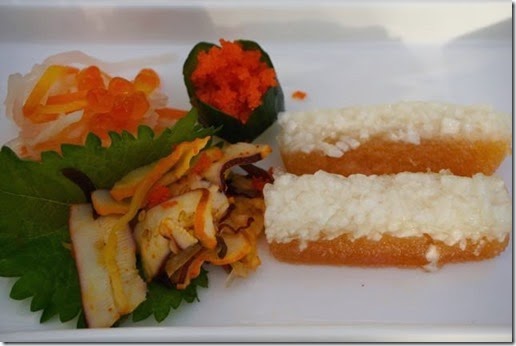
The octopus salad was often served as otoshi at Takogrill but this was the first time we (my wife) found it at our regular Japanese grocery store. Besides slices of boiled octopus legs, it has thin strips of seasoned bamboo shoots or menma メンマ with "Chinese-style" seasoning.
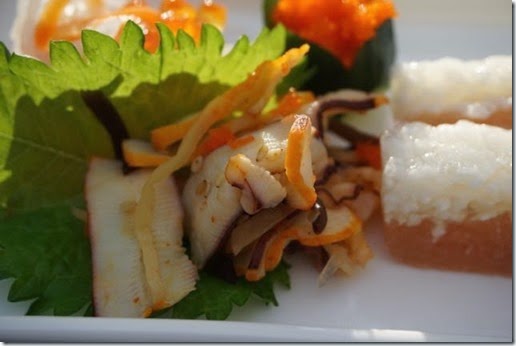
Of course, the main item was my tarako and nagaimo gelée. I posted this some years ago. This time instead of Tabasco, I used Sriracha.
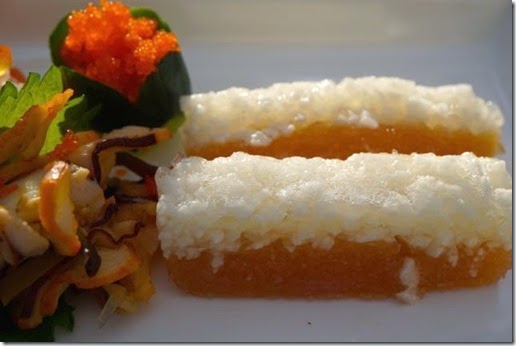
All items on this plate were just perfect for sake, we admired the cherry blossoms and tasted a little of these items and sipped sake. Is there any better way to spend a perfect spring day?
Wednesday, April 6, 2016
Hanami 2016 花見 2016
Using whatever I had, I also made a small simmered dish or nimono 煮物 from nagaimo. grilled tofu 焼き豆腐 and shirataki 白滝.
Friday, December 2, 2022
Tuna, avocado and nagaimo cubes まぐろ、アボカドと長芋の角切り
One evening, we defrosted Chutoto bluefin tuna まぐろの中トロ from Great-Alaska-Seafood. I divided it into 4 parts thinking that I will make 4 different dishes. I served one part of it as straight sashimi, and second part as imitation negitoro 擬制ネギトロ. I made the third part as “zuke” marinated slices of tuna 漬けマグロ. I planned to make the 4th part to our usual Yamakake 山かけ but we had freshly cooked rice, so instead, we went for a small tuna donburi using the marinated tuna sashimi or “Zuke” 漬け鮪丼. This was quite filling and we decided to keep the tuna prepared for Yamakake for the next day. This was cubes of tuna marinated in x4 concentrated Japanese noodle sauce (short-cut version of “Zuke”). Next day, instead of making Yamakake, I came up with this hybrid of Yamakake and tuna avocado cubes マグロとアボカドの角切. This turned out to be quite good with similar soft consistency of tuna and ripe avocado and crunchy refreshing cubes of nagaimo 長芋.
Tuna Sashimi, 1/4 block, cut into small cubes and marinated in x4 concentrated Japanese noodle sauce (few hours but in this case 24 hours).
Half ripe avocado, cut into similar sized small cubes and dressed with lemon juice to prevent discoloration.
I inch nagaimo, peeled and cut into small cubes
One clove of garlic finely chopped
two scallion, finely chopped
Dressing:
1/2 tsp dark sesame oil
1 tbs soy sauce with dissolved wasabi
I topped with dried nori strips.
This was a quite good appetizer with cold sake.
Sunday, December 8, 2013
"Nuta" salad from frozen yellow fin tuna 冷凍キハダマグロのぬた

One of the reasons I made this dish was that we had a similar dish (made with better quality tuna) at Kappa in San Francisco.
Block of yellow fin tuna: I used about 1/3 of the block. After thawing, I put the block in boiling water with a dash of sake for 10-15 seconds until the surface turned white all over. I then put it in ice water. After 30 seconds, I fished the tuna block out of the water and patted it dry with a paper towel. I cut the tuna into bite size cubes.
Scallion: I only used the green part of the scallion (4-5 stalks), I cut them into 1 inch segments and blanched them for 1 minute, then soaked them in ice water and drained.
Wakame seaweed: I used salted and frozen wakame (not dry one). I washed it to remove the salt and soaked it in cold water for 10-15 minutes to hydrate. I cut it into short segments.
Cucumber and Nagaimo: Both were cut into small dices (skin peeled from nagaimo).
Dressing: This is my usual karashi sumiso dressing.
This low- quality frozen yellow fin tuna tasted quite decent in this dish.

I also made “Namerou” of tuna with garlic, ginger, scallion and miso (above) which was quite palatable with sips of cold sake.
I also made “Yamakake” using the remaining block of tuna. I marinated the small cubes of tuna in a mixture of sake and soy sauce in the refrigerator for a few hours prior to serving.
With these three dishes, we finished the entire block of yellow fin tuna.
Wednesday, August 7, 2019
Yamakake variation 山かけバリエーション
For greenery, the recipe called for "Daikon" sprouts which I did not have so I just used thinly sliced American mini-cucumber.
Instead of grating nagaimo, I made small chunks by crushing it in a Ziploc bag using a meat pounder. This is called "Tataku". Most frequently, this is done to cucumber called "tataki kyuri" 叩き胡瓜 so that the seasoning will cling better to the irregular surface. For nagaimo, this process gives a nice crunchy texture (chunks) with a grated texture along the edges of the chunks. We like this combination of the textures very much.
One more additional step was called for in preparing the tuna. After a few hours of marinading, I sandwiched it between hydrated kelp which is called "Kobujime" 昆布締め. This is usually done for white meat fish but as per the recipe I added this step. I did this for 1 hour. Before cutting the tuna in into smaller cubes.
We really liked this version of yamakake. We are not sure "kobujime" process really added much though. In any case, this was definitely wroth trying again (hopefully with better quality tuna sashimi).
Monday, April 10, 2023
Firefly Squid Scallion Pancake ホタルイカ入りネギ焼き
Ingredients (make 4 pancakes)
12 firefly squids (3 per pancake) or more if you like
50 grams grated nagaimo (mine was near 80 grams)
9 tbs chopped scallion (I used 5 stalks)
1 egg (I used 2 eggs)
2 tbs AP flour
1 tsp granulated bonito dashi (I used “Hondashi”ほんだし)
1 tsp soy sauce
1 tbs vegetable oil
Directions:
Since I was using more grated nagaimo than the amount called for in the original recipe, I changed the amount of eggs as a binder. I did not add the firefly squid into the batter initially. I divided the batter into 4 portions and added 3 squid to each batch.
I heated up a non-stick frying pan on medium heat and added the oil. I poured in 4 potions as seen below.
After a few minutes or when the bottoms are set and brown, I flipped the pancakes and lowered the heat and continued cooking for another 2-3 minutes or until the center was done.
Friday, August 6, 2021
Big eye tuna sashimi 4 ways めばち鮪刺身 四通り
Friday, March 2, 2012
Chicken "tsukune" with lotus root; two ways 蓮根入り鶏のつくね、2種類
Tsukune mixture: I hand chopped to make ground chicken from thighs (2 large) but of course you could just buy ground chicken or use a food processor. I like to use thigh meat with a bit of fat. I mixed in finely chopped onion (1/2 small), ground ginger (1/4 tsp), sliced and chopped lotus root (1/4 of vacuum packed pre-boiled), yuzu-kosho (1/2 tbs or more). As I mentioned, one could add more ingredients such as ground nagaimo or yamaimo, tofu, beaten egg etc. Using the same mixture I cooked it in two ways.
In the first version, I spread the meat mixture on the square (1/4 of full nori sheet) of nori and fried it--meat side first and then nori-side. Dishes with nori involved often include a word "seashore" or "Isobe" 磯辺. So this is "Isobe" grilled chicken patty. I made an equal mixture of mirin and soy sauce and added it to the pan towards the end of cooking and coated the chicken patties. After removing the patties from the pan, I further reduced the sauce until it was rather thick and put back the patties to coat. I sprinkled Japanese "sansho" 山椒 powder. I served this with "kinpira" or braised lotus root (This was made from the remaining lotus root, a subject for another post). I should have taken pictures with this dish turned over to show the piece of nori.
The next day using the same mixture, I made the tuskune in the regular way (pan fried and then braised in mirin and soy sauce) and served it with celery salad with powdered kelp or "kobucha" 昆布茶 and olive oil.
Tuesday, July 23, 2019
”Otsumami” appetizer snacks 酒の肴(おつまみ)
We both get filled up quickly so I try to serve small portions. In small bowls from left to right are cold tofu or hiyayakko 冷や奴, grated "Tororo" nagaimo とろろ with "ikura" salmon roe and "Chinese -style" squid salad 中華風イカサラダ
On the black rectangular plate are boiled octopus leg thinly sliced with sumiso sauce タコの酢味噌, my usual dashi-maki Japanese omelet with aonori sea weed 青海苔だし巻き玉子, store bought small fish cake re-heated in the toaster oven.
The gyoza 餃子 I made a few days ago heated up in the toaster oven (skin becomes really crispy) cut in half with a small amount of Ponzu sauce ポン酢 poured into them. This replaces the separate dipping sauce and makes it a bit easier to eat the gyoza.
This store-bought boiled squid salad with Chinese flavors.
This is grated nagaimo (which is called "Tororo"とろろ). I dissolved wasabi into soy sauce and mixed into tororo and topped it with ikura and chiffonade of perilla.
This is cold silken tofu. I added blanched edible chrysanthemum 春菊. Instead of straight soy sauce I dressed it with concentrated noddle sauce and topped it with bonito flakes かつお節.
We had these small dishes with our house cold sake "tengumai" daiginjo 天狗舞大吟醸. Nothing really new here but very enjoyable.


































